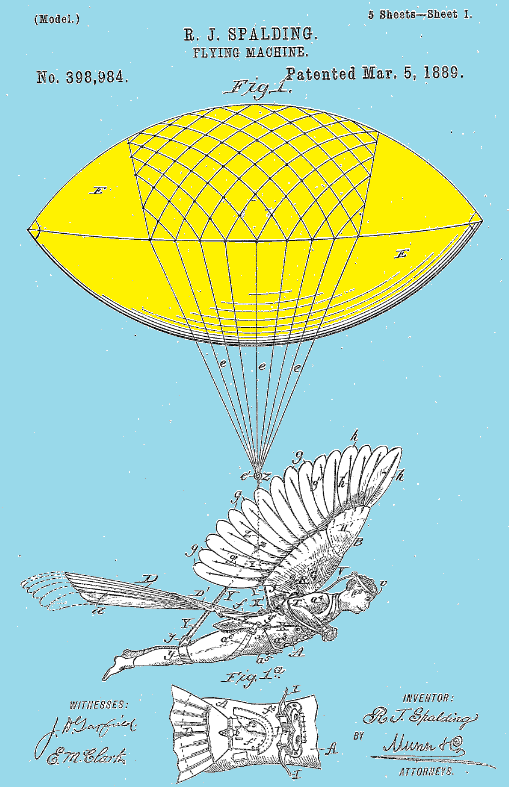It may come as a surprise to many, but the Wright brothers were not the first to be awarded a U.S. patent for a machine that would enable people to fly.
To stick a pin in the U.S. patent timeline, Wilbur and Orville Wright filed their application on 23 March 1903 and were awarded U.S. Patent 821,393 on 20 May 1906. Since the Wrights were the first to invent a fully controllable, powered aircraft that could take off, fly, maneuver, and land, it's natural to think their patent was the first ever awarded for a flying machine.
But it wasn't. The IIE team was excited to find another patent for a flying machine that was awarded to its inventor on 5 March 1889, some fourteen years and eighteen days before the Wright's filed their application with the U.S. Patent Office!
U.S. Patent 398,984 was awarded to Reuben Jasper Spalding of Rosita, Colorado and, dare we say, it is a stunning document detailing some of the most advanced aeronautical thinking that preceded the Wright's invention. Because mere words cannot do it justice, here is Figure 1 from the patent:
The text of the patent begins with a simple proclamation:
Be it known that I, REUBEN JASPER SPALDING, of Rosita, in the county of Custer and State of Colorado, have invented a new and Improved Flying-Machine, of which the following is a full, clear, and exact description.
My invention relates to a machine for navigating the air, and has for its object to provide a simple, comparatively inexpensive, easily-operative, and efficient apparatus of this character.
The patent's text proceeds to get into the technical description of Spalding's flying machine apparatus. It's not until close to the end that Spalding provides his vision of how humans, now known as aeronauts, could navigate the skies with his invention:
When the aeronaut is flying, the wings operate with practically the same effect as the wings of an eagle, and the aeronaut may easily turn either way by holding one of the wings in horizontal position and working the other wing, and he may assist himself in taking a different course by laterally spreading either side portion of the tail.
Of course, we need not go into great detail to describe how the aeronaut would power their flight across the sky, because....
It is obvious that the aeronaut has ample power to direct his course and fly with the wind or diagonally across it, or to any point of the compass in a calm, as he may desire. As the wins flap up or down, the flexible portions of their feathers bend and while bent they are trying to straighten and this action or tendency pushes the man or craft forward, producing headway, while at the same time the alternating pressure of the front ends of the feathers downward and upward, which takes place while the bent feathers are trying to straighten, counteracts the unfavorable action of the web portions of the wings and consequently produces an equilibrium.
Spalding's invention is surprising similar to the modern wingsuit, which simplifies his flying machine concept and does away with the balloon portion of the invention
Speaking of which, Spalding was already thinking about doing just that, but he had a different concept in mind for how else his aeronaut's flying apparatus might be used:
It will be understood that the flying-machine comprising the wings and tail or the wings alone and their attachments, as above described, may be used advantageously without the balloon. For instance, the cord Z may be suspended from a pulley running on a wire stretched across a chasm or at other place, and the aeronaut may operate the wings to propel himself through the air while he is supported mainly or partly by the wire; or the wings, either with or without the tail, may be applied to vehicles or ice or water boats or an air-boat or frame-work, and the wings may be operated by man or animal or electro-magnetic or any other pwer for moving the vehicles or frame-work forward.
In other words, Spalding saw his invention being used for activities surprisingly similar to ziplining and parasailing. While his concept of a flying machine is far from what became common in the over 130 years since, there's no question Spalding's innovation fortold some small parts of the future that came to be.
From the Inventions in Everything Archives
The IIE team has a long history with things that either fly or float through the air. Here's a short list:
